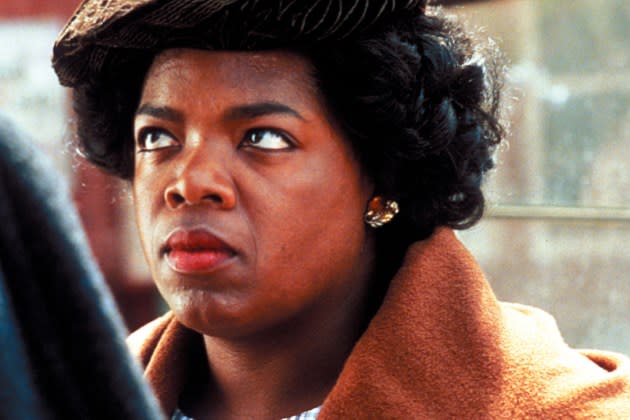‘The Color Purple’: THR’s 1985 Review
- Oops!Something went wrong.Please try again later.

On Dec. 16, 1985, Warner Bros. unveiled Steven Spielberg’s adaptation of The Color Purple at its premiere in New York. The film went on to garner 11 Oscar nominations, including for best picture, at the 58th Academy Awards. The Hollywood Reporter’s original review is below:
To those who think of Steven Spielberg solely as the creator of sci-fi adventure movies or high-tech horror films, The Color Purple will come as an exhilarating surprise. It’s a film filled with tenderness and love, the enduring love of two sisters cruelly separated in their childhood, the love of one of them for two infants taken from her at birth. Based on Alice Walker’s Pulitzer Prize-winning novel, it tells us quite simply that every thing and everybody needs love, and that putting our faith in love will make everything come out all right.
More from The Hollywood Reporter
While I wish with all my heart that I were sanguine enough to believe this, I can’t deny that when The Color Purple is on the screen, it all seems possible. Such is the conviction of Spielberg’s directing, and the large cast that brings his convictions to life. For all its darker colorations, the film is a lyric ode to the goodness in mankind. Even the brutal, meanspirited Mr. Albert (Danny Glover) softens in the end.
The supreme test for any filmmaker is his ability to create a universe that, for two hours or so, makes you believe that it really exists. Spielberg has repeatedly revealed this kind of creativity, but never more persuasively than here. Set in the South, its story bridges almost 40 years, from 1909 to about 1947, and concentrates almost exclusively upon the black community in a rural settlement. (The main exceptions are the mayor of the neighboring town and his condescending wife.)
As written by Menno Meyjes, the film is centered on the tragic yet triumphant story of Celie, given in marriage at age 14 to a man who doesn’t love her by a father who has already abused her sexually. Celie becomes quite literally a slave to her husband, demeaned and mistreated in every possible way; his heart belongs to Shug Avery, the blues singer his father has refused to let him marry. When Albert brings the ailing Shug into their home, Celie cares for her tenderly and the two become friends. It is Shug who puts Celie on the path to self-awareness and a recognition of her own worth. Shug also uncovers the letters (the basis of Walker’s novel) that reveal to Celie that her beloved sister is still alive.
Surrounding these are a large and lively group of supporting characters — Albert’s martinet of a father, his four children from a previous marriage, the spirited Sofia, who married Albert’s oldest boy, Shug’s father, a minister, and some of her big-city boyfriends. They brawl, they quarrel, Sofia has a run-in with the mayor’s wife that lands her in jail from which she emerges years later in a nearly catatonic state. But it all remains completely local; the two major wars never touch their lives, nor any of the rural measures of the Roosevelt administration mainly, I suspect, because reference to these might change the focus of the script.
Instead, by concentrating on these people, Spielberg demonstrates how the lack of love or understanding, the blind yielding to prejudice or passion, can damage other lives, while, conversely, compassion and an open heart can bind up the wounds. It may seem a rather elementary lesson, but how many films can you think of that have preached it lately?
Not that The Color Purple is by any means a preachment. There is too much feeling in its exploration of the bonds between people who care for each other, too much spirited action as when the patrons of the ramshackle bar in which Shug is performing follow her en masse to join the gospel singers in her father’s church, or when a family fight breaks out over a Christmas dinner. And there is a wonderful feeling that all’s right with the world when the women finally begin to break free of their male domination and to assert themselves.
With notable assists from production designer J. Michael Riva and cinematographer Allen Daviau, this Warner Bros. release achieves a strong sense of place, even though this isn’t the South that we have grown accustomed to. These people don’t live in tumbledown shacks with tarpaper walls; they own what appear to be former plantation houses which, while certainly not Taras, affirm a certain economic stability that serves to tie them more closely together. They aren’t concerned about losing their land, but losing their loved ones.
Spielberg has assembled an extraordinary cast for the occasion, headed by Danny Glover, whose Albert is a tower of malevolence warmed only by the presence of Shug, and by Whoopi Goldberg, whose emergence from slavery to radiant womanhood is a joy to behold. As Shug, Margaret Avery runs the gamut from friend to vamp to repentant sinner and belts out a pair of Quincy Jones’ best in the bargain. Oprah Winfrey offers a sturdy, mettlesome Sofia, and Adolph Caesar sneers a lot as Albert’s overbearing father.
All these people and all these events are smoothly, seamlessly held together by Spielberg’s flawless direction, in which the tonalities are often more eloquent than the dialogue, and where the music (by Jones) is as integral as the action. Perhaps not everyone will be able to buy into his special world, a world governed by emotion rather than economics. But I can only view it as their loss; they will miss one of the loveliest parables ever created for the screen. — Arthur Knight, originally published on Dec. 17, 1985.
Best of The Hollywood Reporter
